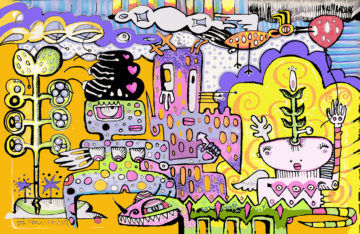
Artistic director, Nadia Hagen shares her journal from a recent trip to Cuba with Tambor Y Danza’s Kimberly Miguel Mullen and Luca Brandoli.
 Kimberly is a talented dancer and ethnologist and Luca is a master musician. A group of eight, traveled for two weeks-on a tour across the island, with stops in Havana, Cienfuegos and the capitol, Santiago. This was a cultural immersion tour, full of song classes and dance taught at the premiere schools on the island with master teachers, as well as trips to museums, cabhildhos and historical landmarks.
Kimberly is a talented dancer and ethnologist and Luca is a master musician. A group of eight, traveled for two weeks-on a tour across the island, with stops in Havana, Cienfuegos and the capitol, Santiago. This was a cultural immersion tour, full of song classes and dance taught at the premiere schools on the island with master teachers, as well as trips to museums, cabhildhos and historical landmarks.
Paul : ‘Gut Morgen Faulein. ME: “ Gut Morgen Super Mensch. “
Paul and I must listen to “PHACE” at 4am.
PHACE is good for driving on the Autobahn or to the Tucson International Airport to catch my flight from Tucson to LA.
I go thru security in Tucson and don’t go thru again in LA – I arrive at the gate for Miami to Cuba ahead of everyone else- completely mystified- This has never happened before- Flying is usually frantic and stressful. I am always held up in security- but this time-no one even wants to look in my bags.
“Hey guys- Doesn’t this look weird? “ What about this?”
That was too EZ- maybe the US is trying to get rid of me.
Kimberly says Cuba is like karma on fast forward- whatever is coming to you is instantaneous- This is just the beginning.
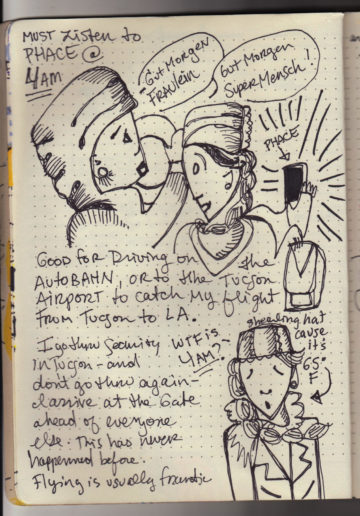

Raices Profundo is a long established dance school in Havana- or El Habana-
Built between the spaces of two, two story edifices- long abandoned- It is like dancing in a rotting cathedral- the intricately tiled walls smell strongly of mold and dog pee.
It is lined with sealed up windows that once belonged to the adjacent buildings and a floor that is rough and pitted. I am torn by the beauty and the apprehension evoked by the obvious danger of dancing on an unpredictable surface like this-
I am thankful for my gold dance sneakers every time I step on a crack.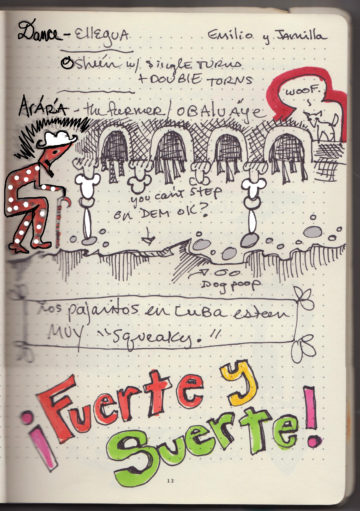
On our first full day we got to dance class and then off to Havana Viejo- Old Havana, the part of the city that is lined with cobblestones and the ancient reservois that distributed the city’s water- Michelle and her Cuban boo walk arm in arm and giggle- he holds her purse- and when I ask him about the reservoirs- with their ancient moss covered steps that lead underground, he says his parents told him that those were prisons- which after research is completely untrue and most likely a story to make him behave.
Little shops and art studios line the streets- I hear the sound of a clave- and remember there was only one present I promised to bring home- Claves for Quiauhuitl. “Wait for me”, I yell. This is unlikely to happen- the group is excited and ready to trek across town. I hate being lost- more than almost anything- which I know is a terrible trait in a tourist- ridiculous, really. Of course I’ll be lost- I’m a tourist.
I remember walking thru the crowded NYC city streets when I was 2 and reaching up for my grandmother’s hand and looking up into a face that was not my grandmother’s and howling in fear- The sound stopped everyone and my grandmother was quickly found- but I go back to that moment when I am lost. Whether in a sea of people or alone- That is how ”lost” feels – and here, the streets are windy, with occasional, almost flippant placards for names- my Spanish is for shit and there is absolutely positively no internet.
It’s a big risk- Judy, the very sexy shop lady, sells me the claves and I run off down the street- hoping my group has not turned down a side street.
It is important to know, that Luca Brandoli is fast.
He is our liason, here in Cuba, and it is a firm consensus, that Luca is fast and he will not wait for you.
I catch up and we enter the Museo de Afrique. This is one of those majestic classical buildings of Havana -Cream colored walls, sleek black wrought iron, high ceilings and marble staircases. Our guide is dressed in Yemaya blues and greens and she introduces us to the curator of the museum- not in person- but portraits of him line the walls of the ground floor. Glass cases, hold hundred year old dolls – carved from wood, with shell eyes and dressed to look like saints to pass the scrutiny of the slave owners.
No one minces words about slavery- no metaphors or skirting the issue- here everything about the severed relationship between the slaves and their native lands forms the threads the people wove to tie themselves back to that place.
Elaborate super bling seashells of all sizes nestle in one glass case and in each corner of the upstairs room is a recreation of an altar for a branch of the Cuban culture.
The Congo altar is the oldest- it’s centerpiece, a huge iron cooking pot- and around it a menagerie of dead things, snakes, a weasel, a turtle and goat horns. It occurs to me that our guide feels the need to “splain” this quite a bit because to the average white person this looks like some witchy shit- which it is, but- so is the shit in my house.
It is, of course about the significance to the users, the associations, reminders and symbols of the energies one must honor and remember.
You know- dead weasels.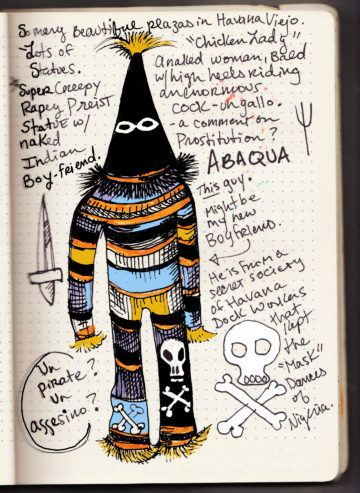
We return to the main hall which is lined with a beautiful collection of masks from Mali, Burkina Faso and Senegal- Masks I have seen in photo books and pinterest searches- but never in real life. The wood grain of them gleams and their expressions reach out to me and make me mirror them- the grimace- the pursed lips, the glowing eyes and knowing smiles. I could stay here with these guys all night- but the museum is closing and we are off again-
We walk through little plazas and and grand plazas- full of tourists- Italians, germans in groups of 30 with their guides- who hold up little signs for all to follow, they gallop through the squares, their hands full of gelado and shopping bags.
Krysta and Makisha buy coco gelado and we all share with tiny wooden spoons.
The plazas are adorned with large bronze sculptures- most notable is the super creepy ode to colonialism that is an over size, over-clothed catholic priest with his arm protectively holding an undersized under clothed native boy close.
I am overwhelmed by yuck.
Not to be outdone in evoking uncomfortable emotions thru bronze is Roberto Fabelo’s social critique of the economics of prostitution in 1950’s Havana-
otherwise known as “Chicken Lady.”
I am told by the Directora of Raices Profundo that stiltwalkers often appear in the square- but sadly not today.
 I need to digress and introduce you to my new boyfriend- it is important to note that Cuban men are all about being “su novio por anoche” which is convenient- if you are into that. But I met my new boyfriend at the Museo de Afrique- His costume represents- the Abaqua- which is – not was – is- a secret society of Havana dock workers that kept the masked dances of Nigeria alive into the present.
I need to digress and introduce you to my new boyfriend- it is important to note that Cuban men are all about being “su novio por anoche” which is convenient- if you are into that. But I met my new boyfriend at the Museo de Afrique- His costume represents- the Abaqua- which is – not was – is- a secret society of Havana dock workers that kept the masked dances of Nigeria alive into the present.
Is he a pirate? An assassin? He didn’t tell me.
A House Ceremony in Havana-an initiation for new Santeros- One for Oxun in yellow and one for Oxala in white- We are just passing by the house and people shout “Luca, Luca” (cause he’s kind of a rock star… ) and we all get shoved and pulled into the already crowded front room- The drummers start slowly – a rhythm and a song for Ellegua, then Oxun, Yemaya and Ogun. Family and friends are packed in tight and the initiates are brought in, in their fresh robes and presented to the Babalau- Each makes an offering to him and then to the drummers- They seem very altered, having gone thru days of rituals and this being the culmination – Their friends and relatives hold out their arms to steady them- and everyone sings and dances. I can tell the better we sing and dance, the happier the oricha will be and this helps the person being initiated- and I feel guilty because it’s my 2nd day and I don’t know the steps or the songs and so I’m not really helping- but everyone smiles and women pull me in closer and I get that it’s the good intention I have for the moment that matters and Cubans are all about that- not the specifics, or the dogma- but the goodwill intended- and the energy is strong and can’t be swayed by a little distraction or worry. The women wear their street clothes- some get a little fancy- and one wears her cute bodycon romper and her flip flops- “sexy casual” that’s what you wear to a spiritual initiation in Cuba- in case you need to know-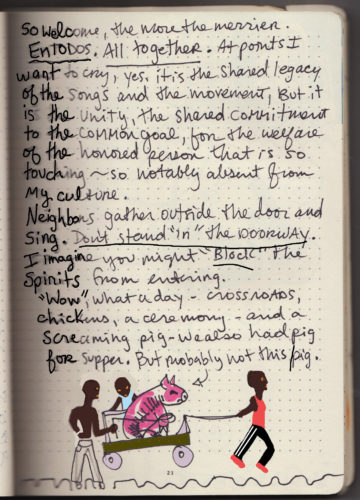
Neighbors gather outside the door and spill into the street. Don’t stand in the doorway! I imagine this blocks the spirits from entering the house- All are Welcome! The more the merrier- EN TODOS, ALL TOGETHER, At points, I want to cry. Yes. It is this shared legacy of sound and movement but it is the unity and commitment to a common goal for the welfare of the honored person that is touching and so notably absent from my culture. (Unless you count singing the dreaded Birthday song)
Wow. That was Day Two. Crossroads, ceremonies and a screaming pig- also we had pig for dinner- but probably not this pig.
Cuba is an island surrounded by water. Tucson is an island surrounded desert.
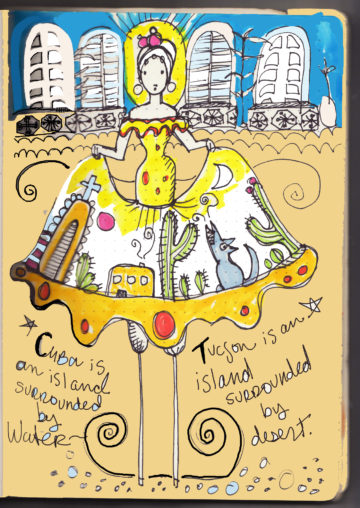
HOW TO BE A COWARD IN CUBA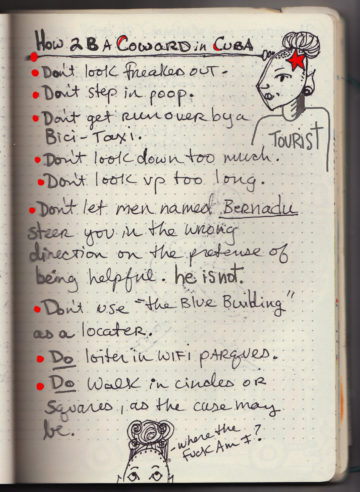
Don’t look freaked out.
Don’t step in poop.
Don’t get run over by a BICI- TAXI.
Don’t look down too much.
Don’t look up too long.
Don’t let men named “Bernadu” steer you in the wrong direction on the pretense of being helpful. He is NOT.
Don’t use “the robin’s egg blue building” as a locater. (there are 50 million of these)
Do loiter in wi-fi parques. (It’s pronounced wee fee.)
Do walk in circles or squares- as the case may be.
Do stop for pop-up reggaeton parties in the street.
